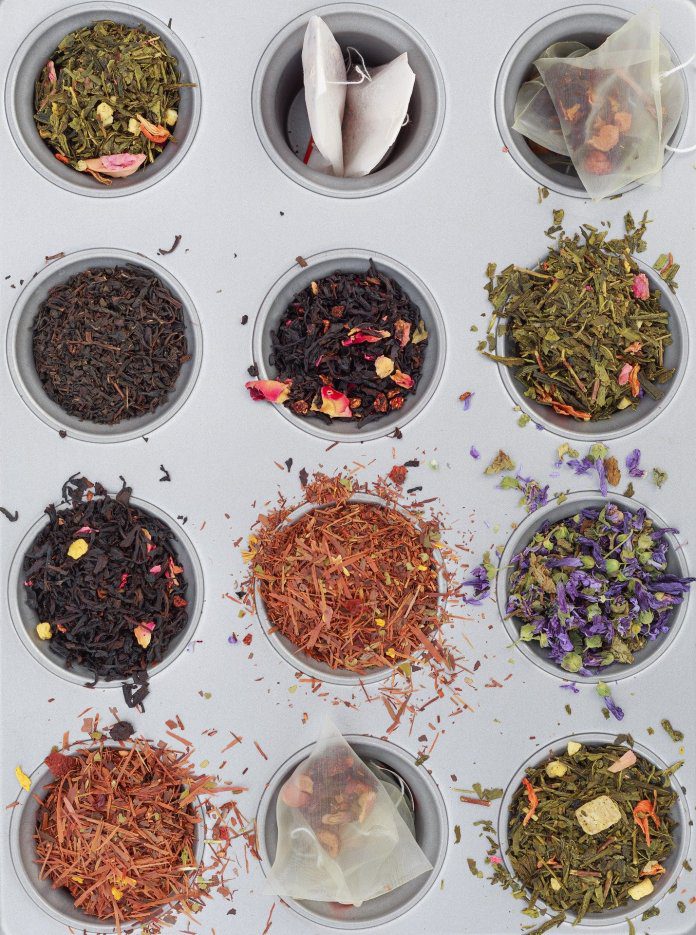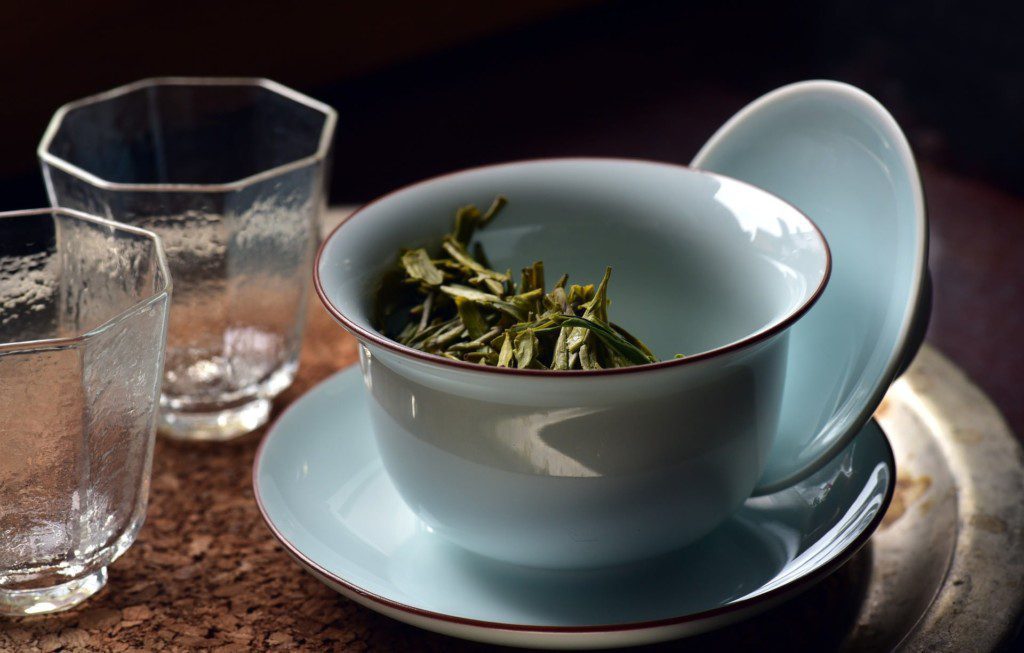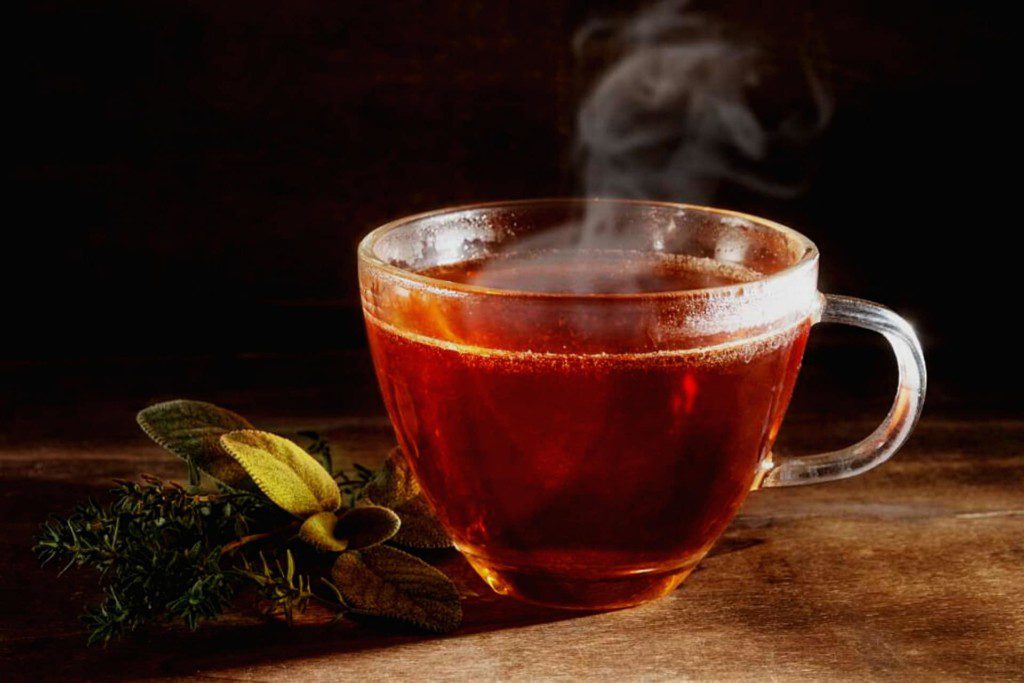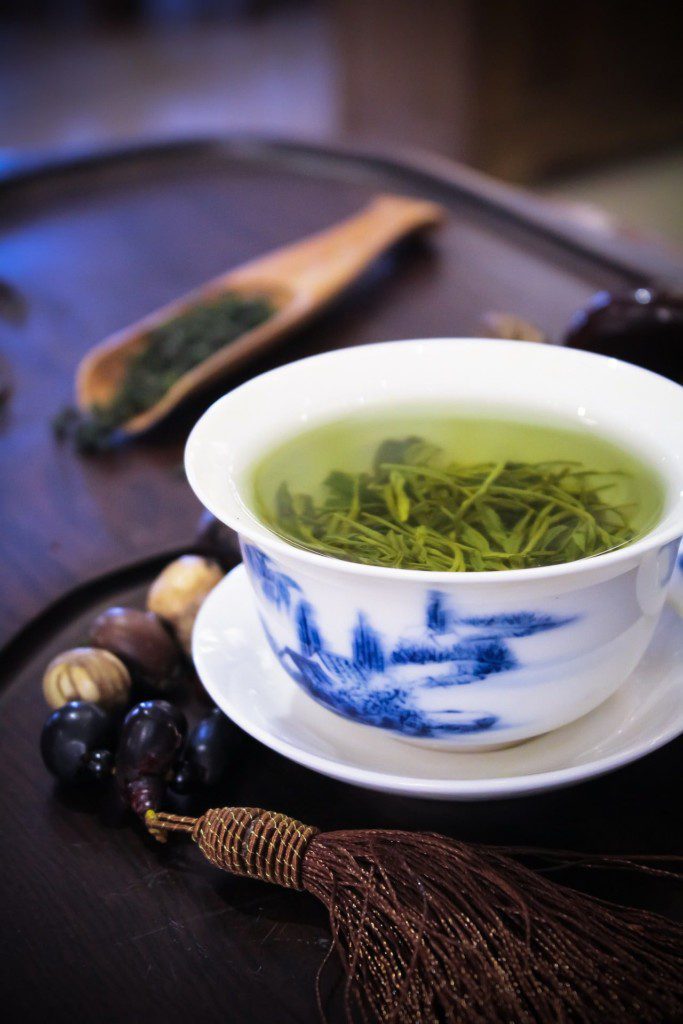Why Does My Green Tea Look Yellow?
Green tea leaves are passed through a steaming treatment. This steam gives radiant heating to the green tea leaves, which makes the process of oxidation halt. It also makes the leaves have a grassy flavor.
Green leaves do not oxidize after rolling, and therefore they have a lighter color when they are brewed. Using high temperatures to brew your tea will give you a more yellow looking tea. This yellow color comes from compounds that quickly dissolve due to the intense heat, just like how the bitter taste infusing compounds dissolve.
The steps to the processing of Green tea are:
- Streaming or Roasting
- Cooling
- First rolling
- First drying
- Final rolling
- Final drying
Why Is My Green Tea Red In Color?
It is a rare case and generally occurs when there is excess oxidation in the oolong tea. It could also arise due to manufacturing defects. The leaves also processed using pan-frying destroy chlorophyll, which is the green color pigment. The yields of such processed tea could also provide a red color.
Is Green Tea That Is Not Green In Color Fake?
Well, it possibly could be original but not grown in the perfect conditions to have a green color. It might not be processed in the right way either – thereby giving it a brownish color. Despite the green tea not looking green, you will still receive the same benefits, so it shouldn’t be a concern.
Origins Of Green Tea

There are many kinds of green tea plant species in the world, regions of China, Japan, India, New Zealand, and Bangladesh are major tea producers. But green tea is said to have originated from China, the Yunan province of China is said to be the origin of the Camellia sinesis plant variety. Green tea is said to be mainstreamed in Japan around the 12th century. To this day, China and Japan are said to be the top exporting countries of Green tea in the world.
To understand the topic of ‘what is the color of the green type’, we must go through its types. Not all types of green tea look the same or taste the same; this is because of the plant variety and how it is manufactured. The type generally depends on the following factors:
- Method of production
- Cultivation practice
- Time of year the tea was plucked
- Was the plant organically or chemically grown?
- Heat applied to stop oxidation
- Are the leaves cut whole and smaller?
There are a lot of green teas that are exported from China and Japan. They differ in looks and flavor because of the origins and distinct methods of processing.
Chinese Green tea
The distinctive characteristic of the Chinese green tea is that it is pan-fried. The tea leaves are heated in a pan to halt the oxidation process. The flavor of the tea can be altered depending upon the type of roasting. Usually, the Chinese green tea has a yellowish-green or dark green color with a grassy, earthy flavor. Common Chinese green tea examples are: Gunpowder and Dragonwell.
The Gunpowder variety is tossed around in a figure-eight pattern by roasting in a perforated metal tumbler; it is named after the pellet shape of the final product leaf. The Dragon Well tea has a toasty taste of the green tea, and has a characteristic flavor that has not been able to be duplicated in any other green tea producing region. It is commonly referred to as the classic pan-fried Chinese green tea.
Japanese Green tea
Steaming is the main characteristic feature of Japanese Green tea. The tea leaves are treated with steam after hours of plucking to stop oxidation, and this brings about the vibrant green color of tea. The steaming process also gives the tea a sweet, seaweed-like, and vegetal flavor. Some of the famous Japanese green teas are:
1. Hojica tea
Hojica tea has a distinct nutty flavor and is made by applying a high amount of heat to reduce the tea’s caffeine content.
2. Sencha tea
Sencha tea makes up a significant proportion of Japan’s tea production. It is very popular among households and restaurants throughout the country. They are made from tea leaves that are rolled into strands and subjected to high amounts of heat.
3. Matcha tea
It is powdered and is used in Japanese tea ceremonies and are also a very popular cooking ingredient.
4. Genmaicha tea
This is made out of Sencha tea leaves and roasted rice, it has a toasty taste and is a popular drink served with food.
5. Gyokoro tea
Gyokoro tea is shaded for the first few weeks after plucking, which intensifies its color and taste. It is rolled into a needle-like shape and is considered by the Japanese as their prized treasure.
Want to try different green variants in terms of flavor. Check out this list of different types of green tea flavors available in the markets.
Taste Of Green Tea

We have seen that Green tea is exported from various parts of the world; the different methods of processing give it different tastes. The general flavor profile of the green tea includes – vegetal, earthy, grassy, buttery, nutty, seaweed-like, lush, and green.
Caffeine Content In Green Tea And Its Effect On Its Taste
Green tea has comparatively lower caffeine content than a regular cup of black tea or coffee. A well-processed cup of tea does have a few mgs of caffeine as it is extracted from a caffeinated plant as well. For an 8oz serving of the beverage, Green tea has 24 to 40 mg of caffeine, black tea has 14 to 61 mg of caffeine, and Brewed coffee has 95 to 200 mg of caffeine. It is best to choose dark green tea for its low caffeine content despite the differences in taste.
Related Reading:
Does your cup of green tea taste bad? Try these hacks that will give you an authentic taste of green tea.
Preparing The Perfect Cup Of Green Tea
- Use fresh water.
- Brew the green tea within the optimum temperatures.
- Don’t make the water too hot and scorch your green tea, and this makes the tea more darker and bitter.
- Use 2 grams of green tea leaves for 8 oz. of water, or check the tea package for specific recommendations mentioned by the manufacturer.
- Use a cover to cover the tea vessel to make sure heat is kept inside the vessel.
- Green tea must be brewed for about one to two minutes.
- Adding milk, honey, lemon and sugar is up to you. Keep in mind that adding milk and sugar is the addition of calories to your light, healthy green tea.
Related Reading:
On a diet? Include green tea in your daily regime to lose unwanted weight with green tea and detoxify your body.
Why Does Green Tea Turn Brown?

1. Processing Method And Quality
Initially, the tea leaves are bright green, however, the difference in processing methods changes the tea color after it is brewed. Japanese green tea is made by steaming. This makes their green color more distinct, whereas the Chinese green tea is processed by exposure to sunlight, making it more oxidized, thereby giving a more yellow or brown color after brewing. This is why the green tea looks yellow.
The greenest of green teas is the Matcha leaves, which are shade-grown for four weeks; they are then finely ground to powder. Hence you can acquire different colors from different brands of green teas because the processing methods might differ between them.
2. Brewing Methods
Processed tea is all about the heating and oxidation, and green tea is extremely sensitive to heat. Because of its increased sensitivity to temperature, if green tea is brewed like you brew black tea, there might differ in the color and taste.
For the green tea to hold its green color, the tea leaves must not be brewed for more than two minutes in water with temperatures of 80 degrees Celsius (176 F). Some people prefer brewing it cold, this brewing method is slower but has a different taste than that brewed hot. Usually, the tea has a green color when brewed cold. Brewing too many leaves will also cause the tea to get darker.
3. Oxidation Levels
The increased oxidation of the green tea leaves will slowly remove its green color. This oxidation makes the green tea brew into a more brownish color. The tea must ideally be stored in a cool, dark place inside an airtight container to prevent it from oxidizing. Green tea that is a year old will have a diminished green color.
4. Natural Decay
The decay of chlorophyll also causes the diminishing of green color in green tea. It can also be reduced due to natural processes like – microbial reactions. Light also plays a vital role in natural decay as it can destroy molecules responsible for color. Green tea must be stored away from direct sunlight.
5. Addition of Honey
Why does the addition of honey change the color of green tea? Oxidizing agents within honey rapidly oxidize the green tea and make it turn brown. This can happen with various brands of honey, which makes the green tea look brown and even black.
Related Reading:
Looking for green tea to buy online? We listed 15 popular green tea brands that you can definitely give a shot at.
Are All Green Teas Equal?

There are distinct differences in the quality of the green teas. Studies have shown that antioxidant content can differ in teas by about 260%. The best way to determine the quality of the green tea is by judging it by its color.
What color is green tea? If the green tea turns out brown, then it is either stale, or there were too many leaves – this could also mean that it has lower antioxidant levels. A bitter taste could also account for an inferior quantity of antioxidants.
Frequently Asked Questions
Here are a few interesting FAQs about green tea.
1. What is the best time to drink green tea?
Early in the morning can be a good time to drink green tea because your metabolism is the highest, which can be further boosted with a nice hot cup of green tea.
It is good to drink green tea in the evening too because that’s when your metabolism tends to be not that high as it is in the morning, so this could be your time to boost up your metabolism a bit.
Never drink tea on an empty stomach. It is best to have it after your meals. You can have it before meals, but make sure that there is a gap of two-hour before you eat. Having it during your meals may cause your body to have difficulty absorbing iron.
2. Will green tea help fix a common cold?
Green tea is popular all over the world for its many purported health benefits due to its high antioxidant content. This antioxidant activity helps support your body when attacked by environmental factors or any kind of infection and also helps encourage a healthy metabolism.
As far as green tea and colds, more research is needed. While green tea might give you an energy boost while you are suffering from a cold and help relax the throat, we can’t be sure about the effects of green tea whether it is for the long term or just momentarily.
3. Does green tea help detox the body?
Green tea is rich in antioxidants which increases the production of detoxifying properties. It also boosts the immune system and helps protect the liver from toxins like alcohol. Adding too much refined sugar in green tea will almost nullify its antioxidant properties.
4. What are catechins?
Catechins are natural antioxidants which are present in green tea. The catechins called epigallocatechin-3-gallate (EGCG) help reduce free radicals in the body and prevent cell damage. Research has confirmed the healing properties of catechins in reducing the risk of various diseases like cancer and heart disease
5. How many cups of green tea should you drink a day?
We know the health benefits of green tea are a lot. But that does not mean overdoing it is recommended. Some people might overdo the consumption of green tea, but on an average, 3-5 cups of green tea per day are enough to reap its benefits.
6. Is green tea caffeine free?
Not all green tea available in the market is caffeine-free, it’s all up to the consumers preference whether they want a caffeinated green tea or caffeinated green tea. Read the labels carefully before buying the best green tea for you.
Final Words
In this article we have answered the most asked question which is “what color is green tea?” And we learnt that, not all green teas are green because there are a lot of factors that dictate what does green tea look like.
It is seen that shaded plants have a greener color once brewed. Greener infusions can be seen in less processed leaves. Green tea’s quality and taste can be determined by the color it exhibits. The brew time, method, and temperature also has an effect on the color the green tea will show.



